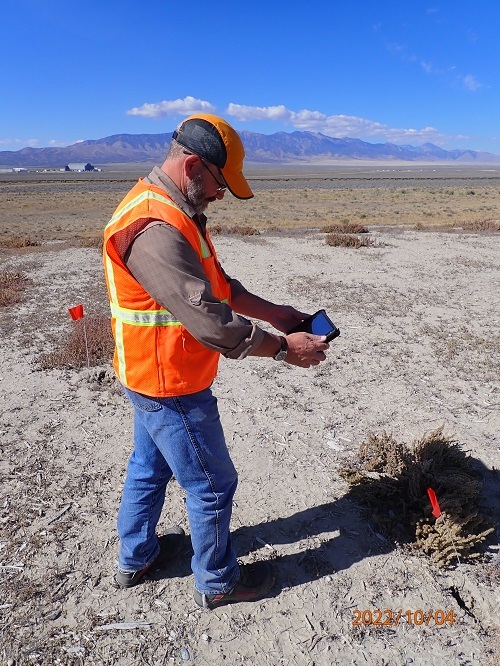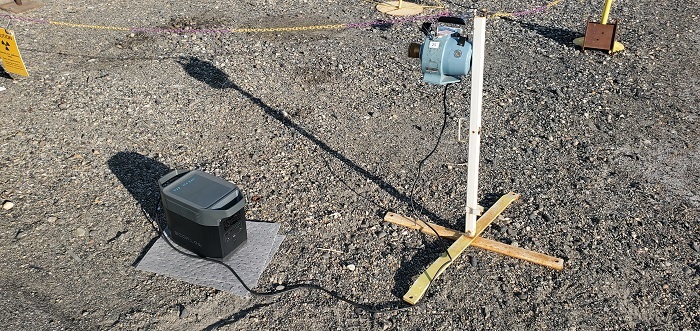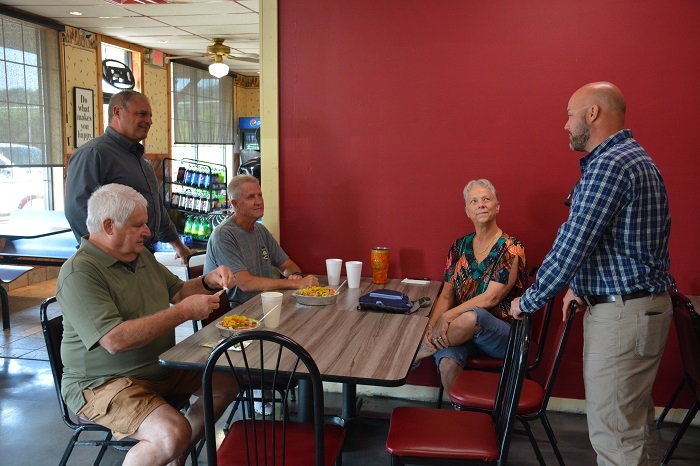 Recent Denmark Technical College graduate Tyjhanera Brown is a welding intern for the Savannah River Mission Completion’s weld shop in H Tank Farm at the Savannah River Site.
AIKEN, S.C. – A graduate in welding from South Carolina’s only historically black technical college is pursuing her passion in the Savannah River Site’s (SRS) Liquid Waste Program.
Denmark Technical College (DTC) graduate Tyjhanera Brown is taking the next step in her journey by becoming a welding intern for Savannah River Mission Completion’s (SRMC) welding shop in the site’s H Tank Farm. The welding shop is where all welders must be tested and certified before starting work for the Liquid Waste Program at SRS. SRMC is EM's liquid waste contractor at SRS.
Brown’s internship is a product of a memorandum of understanding signed in July between SRMC and DTC. One of the partnership’s goals is to prepare students for their future careers through internships and apprenticeships.
Brown’s interest in welding “sparked” in high school, where she was able to attend a course on welding.
“I was interested in welding when I first heard about it,” Brown said. “Once I attended those initial classes, I knew it was something I wanted to pursue for my career.”
In her internship, Brown assists weld-test administrators, prepares weld test material, and performs necessary housekeeping. She also practices her skills by welding up to three plates a day under the supervision of the team at the welding shop.
An internship with SRMC is a great way to start a welding career, according to Brown’s mentor, SRMC Welding Inspector Randy Rimes.
“This program allows for interns to receive the hands-on experience they need for a successful career at SRS or any other industry,” Rimes said. “We don’t just teach interns how to weld; we teach them how to work.”
Brown believes internships are important for gaining real-world experience in an industry.
“I see this internship as a chance to grow, not just as an intern but as a future worker,” Brown said. “Having an experienced team to show me the ropes is a one-of-a-kind opportunity.”
In the future, Brown would like to become a welder in the aerospace or automotive industries.
-Contributor: Lindsey Kennedy
IDAHO FALLS, Idaho – EM is using an innovative system at the Idaho National Laboratory (INL) Site to streamline an annual inspection process and reduce resources needed to complete reports.
EM contractor Idaho Environmental Coalition’s (IEC) Environmental Restoration (ER) program monitors approximately 122 sites with restricted access where cleanup has been completed across the 890-square-mile INL Site.
Until recently, personnel inspecting those sites filled out paper forms and took photographs. Then they scanned the forms and downloaded and sorted images of each site they inspected upon returning to their offices. It was a time-consuming process that generated a lot of paperwork.
Knowing there could be a better way, ER technical support staff members Kristina Alberico and Rick Powell created an application for computer tablets that converted the entire process from paper files to electronic folders.
Auditors recently identified the automated inspection method as a specific system strength.
It’s a streamlined system that ER Director Rich Abitz says saves time and uses significantly fewer resources.
“The new app helps everyone involved with annual inspections by capturing the photos and data and transferring them to a server in real time,” he said.
 |
|
Chris Vilord, a technical specialist with the Environmental Restoration program for EM contractor Idaho Environmental Coalition (IEC), surveys a landfill site at the Test Area North at the Idaho National Laboratory Site using an automated inspection process developed by IEC employees. |
Donna Nicklaus, Waste Area Group 10 manager for IEC, said data collected from the automated inspection method goes into an annual report, and the state of Idaho and the U.S. Environmental Protection Agency (EPA) can go online to download a report to see the status of all sites.
“The agencies love it,” she said of the automated inspection method. “They went out to the site with us, and they were pretty impressed.”
EM is a partner with the state of Idaho and EPA to implement the Federal Facility Agreement and Consent Order signed in 1991. It outlines a plan to investigate and clean up, if necessary, more than 500 individual waste areas within the INL Site.
Nicklaus said the ER program must replace signs at sites with restricted access due to the harsh desert weather. She said employees also monitor for soil subsidence — which is the gradual caving in or sinking of soil — vegetation and even animal intrusion by badgers and other burrowing animals.
She said the automated inspection method makes everything much easier and eliminates the potential for human error in filling out the many data fields.
“It’s really slick,” she said.
-Contributor: Erik Simpson
 A virtual museum featuring the Paducah Gaseous Diffusion Plant was developed through a collaboration between DOE and the University of Kentucky Center for Applied Energy Research’s Kentucky Research Consortium for Energy and Environment.
PADUCAH, Ky. – A virtual museum cataloging the history of EM’s Paducah Site is available online here.
The virtual museum commemorates an important era in western Kentucky’s history. The Paducah Gaseous Diffusion Plant (PGDP) was built in the 1950s to enrich uranium for military nuclear reactors and weapons development, and later supported the nation’s commercial nuclear power program.
The site manufactured low-enriched uranium, which was further enriched and processed at the Portsmouth Gaseous Diffusion Plant in Piketon, Ohio and the K-25 plant in Oak Ridge, Tennessee.
Upon entering the virtual museum, visitors can learn about the processes used at the PGDP, as well as find detailed information on why Paducah was chosen as an enrichment site.
Virtual museumgoers can also expect to find a comprehensive history of the PGDP ranging from how it all began, life at the plant, timelines, missions at the site and more. The virtual museum incorporates personal accounts from past employees on what it was like to work at the PGDP through the museum’s “Faces of PGDP.” Another feature of the virtual museum is the Sights and Sounds section, which highlights dozens of photos and videos that encompass the rich history of the site.
“After World War II, nations around the world began advancing their nuclear arms capabilities, and Paducah played a vital role in protecting our nation’s interests and securities against these foreign threats,” EM Portsmouth/Paducah Project Office Site Manager Joel Bradburne said. “The virtual museum honors the legacy of the many workers whose hard work contributed to the advancement of science and the protection of our national security during those uncertain times.”
By the 1960s, the Paducah plant was dedicated to supplying enriched uranium for nuclear power plants and operated within that mission until 2013. The plant was returned to DOE in 2014.
The virtual museum was developed in collaboration with the University of Kentucky Center for Applied Energy Research’s Kentucky Research Consortium for Energy and Environment, through funding provided by DOE.
 Hanford Site tank operations contractor Washington River Protection Solutions is “going green” by using new battery-powered electric generators for some fieldwork.
RICHLAND, Wash. – Workers with EM Office of River Protection (ORP) tank operations contractor Washington River Protection Solutions (WRPS) are “going green” with new battery-powered electric generators on the Hanford Site.
Crews at the site are working to retrieve and treat radiological and chemical tank waste. Many of the original tank farms, where the waste is stored in underground tanks, were built without the power infrastructure necessary to support modern-day cleanup and monitoring efforts. In the past, workers used small, gas-powered generators to operate things like air samplers, cameras, lights, vacuums and other equipment.
“We have a great interest in addressing environmental, safety and cost-related concerns,” said Ricky Bang, ORP Tank Farms Program Division director. “With the new battery-powered generators, you eliminate gas generator exhaust fumes, and reduce the hazards to the workers and the environment.”
 Washington River Protection Solutions is changing out gas-powered generators for new “green” battery powered generators on the Hanford Site.
The zero-emission generators are also lighter and quieter than their gas-powered counterparts. They require less upkeep and crews do not need to keep gasoline on hand, eliminating a potential hazard.
“They use batteries to supply power, and the battery packs are good for more than 500 charges,” said Barry Orth, a WRPS field crew manager. “Additionally, they charge from a standard electrical outlet and can be outfitted with up to four solar panels.”
Initial field use suggests a fully charged electric generator can last an entire shift and requires minimal maintenance. The one-time purchase of an electric unit nearly equals the annual maintenance costs of a gas-powered generator.
 New, zero-emission electric generators being used in the Hanford Site tank farms are quieter than their gas-powered counterparts, require less upkeep and eliminate potential exposure to exhaust fumes.
“Our switch to battery-powered generators started with an employee identifying a possible area of improvement, researching the issue, then following the proper channels to help further our mission in a way that reinforces WRPS core values,” said Jim Geary, WRPS chief operating officer. “Our focus is reducing the environmental risk posed by 56 million gallons of hazardous waste stored in underground tanks; our commitment includes doing the job safely with a strong focus on innovation, employee involvement and environmental protection.”
The successful implementation has since improved efficiency, mitigated potential hazards and prompted discussion about utilizing other electric-powered equipment at the Hanford Site.
-Contributor: Derek Miceli
 Fluor-BWXT Site Project Director Greg Wilkett, far left, and EM Portsmouth Site Lead Jeremy Davis, far right, talk about the site’s cleanup progress with retirees Bob Winegar, Bob Mollette and Teresa Mollette, who formerly worked at Portsmouth.
PIKE COUNTY, Ohio – EM’s Portsmouth Site has gone by more than one name — locals often refer to it as “A-Plant,” for example — and a variety of contractors have worked on the cleanup there over the past 70 years.
However, the one thing that has remained the same is the dedicated workforce behind the site’s success.
Once a month, retirees spanning generations of workers gather for lunch and an afternoon of stories and conversation.
Recently, the luncheon featured three special guests: EM Portsmouth Site Lead Jeremy Davis; Fluor-BWXT (FBP) Site Project Director Greg Wilkett; and FBP X-326 Demolition Director Mike Furner. FBP is the Portsmouth Site decontamination and decommissioning contractor.
“It is great to meet with those who spent decades dedicated to the safety and mission of the site and are still invested in our progress,” said Davis. “Many of these folks made their homes in southern Ohio early on in the project and raised their families here. They truly are a part of the history of our community.”
The monthly luncheons have become popular among the retirees, growing in number of attendees and representing a wide range of job titles over the years.
-Contributor: Jack Williams
|